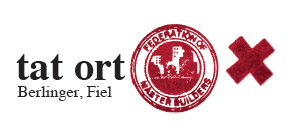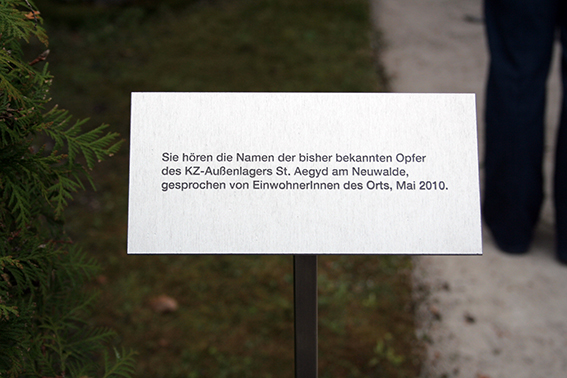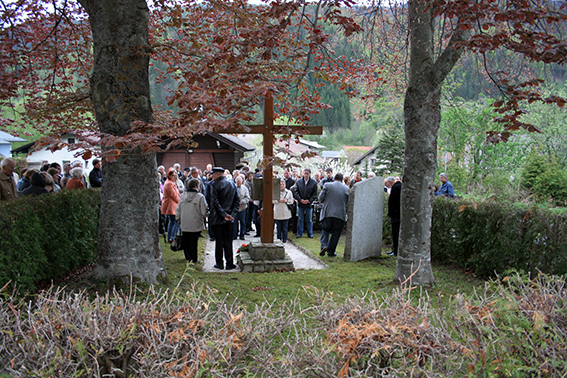Gedenkstätte St. Aegyd am Neuwalde
Permanente Klanginstallation, 2010
Die Ausgangslage unserer Arbeit in St. Aegyd bestand darin, die bestehende Gedenkstätte um die Namen der bisher bekannten 46 Opfer zu erweitern. Abgesehen von einem schlichten Holzkreuz, das nach Kriegsende am Rande des katholischen Friedhofs der Gemeinde errichtet wurde, hat sich erst ab Mitte der Achtzigerjahre eine örtliche Gedenkinitiative der aktiven Erinnerung an die damaligen Geschehnisse im Rahmen eines alljährlich stattfindenden Schweigemarschs angenommen. In diese Zeit fällt auch die Errichtung eines Gedenksteins. Die Gedenkstätte ist daher auch ein Spiegel der zeitgeschichtlichen Entwicklung im Umgang mit der Erinnerung an die Existenz des Lagers, weshalb wir uns dazu entschlossen haben dem Gedenken an die Opfer eine Form zu geben, die sich nicht physisch manifestiert und die BewohnerInnen der Gemeinde aktiv in den Erinnerungsprozess miteinbezieht.
Mit der Entscheidung den Namen der Opfer eine Stimme zu geben, haben wir damit begonnen gemeinsam mit Christian Rabl, dem Initiator und Obmann der neu gegründeten Gedenkinitiative KZ-Außenlager St. Aegyd am Neuwalde, in der Gemeinde von Haus zu Haus zu gehen und die BewohnerInnen zu bitten den Namen eines Opfers laut zu sprechen. Die aufgezeichneten Beiträge werden in Entsprechung zu den zwei Bäumen im Inneren des räumlich abgegrenzten Gedenkorts über zwei Richtlautsprecher nacheinander und abwechslungsweise von je einer Seite abgespielt. Die Beteiligten sorgen mit ihrer eigenen stimmlichen Identität dafür, die Erinnerung an die Opfer vom konkreten Ort des Gedenkens in die Häuser der Gemeinde zu tragen. Aufgrund der geringen Lautstärke sind die Namen nur bei Betreten der Gedenkstätte hörbar.
Im Beisein von Rajmund Pajer, dem letzten noch lebenden ehemaligen Insassen, wurde im Rahmen eines Schweigemarschs die Klanginstallation am 7. Mai 2010 ihrer Bestimmung übergeben.
Berlinger/Fiel, 2010.
Literatur:
Christian Rabl, Das KZ-Außenlager St. Aegyd am Neuwalde, Bundesministerium für Inneres (Hrsg.), Mauthausen Studien Band 6, Verlag des Bundesministeriums für Inneres, Wien 2008.
Rajmund Pajer, Ich war I 69186 in Mauthausen, Peter Gstettner und Christian Rabl (Hrsg.), Kitab-Verlag, Klagenfurt-Wien, 2010.
St. Aegyd Memorial
Permanent soundinstallation, 2009
In 2009, tat ort was invited to work on a proposal for the extension to an existing Memorial in St. Aegyd am Neuwalde, a small village of about 3,000 inhabitants, and located in the southern periphery of the Austrian province of Lower Austria. The Memorial is to mark and to commemorate the existence of a satellite to the Mauthausen concentration camp[1] during the last two years of the Second World War. Whereas the former main camp in Mauthausen has been a nationally and internationally recognised public memorial since 1947, the sites of the former satellite camps have largely sunk into oblivion. The Mauthausen commemoration service under the auspices of the Austrian Federal Ministry of the Interior has therefore established an initiative for the preservation and documentation, as well as for the provision of information about the sites of former Mauthausen satellite camps. It was not until 2008, when the young historian Christian Rabl, who was born and grew up in St. Aegyd published the first comprehensive study on the camp in the village (Rabl, 2008), that the sheer number, the names, and nativity of the victims was known and publically disclosed. In 1942, the concentration camp Mauthausen had five satellite camps. Another ten were founded in 1943 and 21 in 1944. In December 1944 there were 72,825 registered inmates in Mauthausen, more than 62,000 of whom were detained in satellite camps. The camp in St. Aegyd was officially established on November 2, 1944 for the purpose of camp construction work and the manufacture of gas turbine engines for tanks, and closed on April 4, 1945. It occupied by up to 303 inmates, primarily from Eastern Europe, mostly detained for their resistance against the Nazi occupation.[2]
At the time of our involvement, the existing Memorial in St. Aegyd, right at the edge of the Catholic burial ground of the village, consisted of a modest wooden rood, which was erected after the end of the War, and a memorial stone with a plaque to commemorate the unknown victims of the camp, erected in the mid 80s by the then newly established local commemoration initiative, which ever since has organized an annual silent protest in honour of the victims. The site as such is a hedged quadrangle with one central entrance and a tree to each side of it.
For the time being, Christian Rabl was able to investigate the names and birthplace of 46 victims and presented us with the task of granting them a permanent presence at the place where they actually have been buried in a mass grave.
The Memorial in its existing form is as much a historic document of the changing attitude towards the events that have led to its erection in the first place, as it is an expression of the culture of commemoration as such, which – in the given case – is further accentuated by the late scientific recovery of the underlying facts. For this reason it has become clear early on in the process that we wanted to preserve the various layers of its historic formation and to keep the physical presence of our own manifestation very limited if not entirely invisible. Most importantly though, we wanted the commemoration to be a collective and lasting effort in that is should involve the local community over a sustained period of time. Furthermore – and certainly as a result of our previous experiences with the youth of the Housing Estate on the Ach – we strove for addressing the local school kids specifically, for it is theirs to preserve the memory of the camp for generations to come.
We decided to grant each of the known victims a voice in the form of their name, and to embark on a journey throughout the village together with Christian Rabl, which has led us from door to door, essentially covering every house in the village, and to ask the citizens of St. Aegyd to utter the name of one of the victims in order to imbue the act of commemoration with the personal identity of the speaker. Each name has been spoken many times over, the recordings of which we’ve assembled to form a continuous loop, and to be played diachronically of two speakers, hidden next to the trees inside the hedge, which surrounds the quadrangle of the Memorial. The sound installation is permanently active, but tuned at a volume that allows for the names to be heard only once the visitor has entered the Memorial. The only visible element is the plaque at its gate.
The days we spent in St. Aegyd were most intense, shaped by many discussions we had with the citizens, not all of which approving, but most encouraging with respect to the affirmative spirit we encountered at the local school, where Christian Rabl had spent a day of informing the kids about the history of the camp prior to our recordings. We have not yet covered every house in the village, but will continue our work in the years to come, further encouraged by Christian Rabl’s recent information, that by now he has received a number of phone calls from villagers who would like to contribute another name to what has already turned into an act of collective and sustained commemoration.
In the presence of Rajmund Pajer, the last surviving inmate of the Concentration Camp in St. Aegyd am Neuwalde, the Memorial was inaugurated with a silent march to the site on May 7, 2010.
Sources:
Rabl, C. 2008. Das KZ-Außenlager St. Aegyd am Neuwalde. Mauthausen Studien Band 6. Bundesministerium für Inneres. Vienna, Verlag des Bundesministeriums für Inneres.
[1] This camp, close to the Upper Austrian town of Mauthausen was established by the SS in August 1938, five months after the annexation of Austria to the German Reich.
[2] For the source of this information see: Rabl, 2008; Pajer, 2010, and the English version of the Mauthausen Memorial Website: http://en.mauthausen-memorial.at/.




